Introduction Enterprise Resourci'on, Risks of Cloud ERP Systems
VerifiedAdded on 2021/06/15
|14
|4420
|147
AI Summary
ERP Systems in cloud computing Student Name Introduction 2 On-premise Enterprise Resource Planning 2 Benefits of on-premise ERP 2 Risks of on-premise ERP 3 Hosted ERP system 4 Benefits of hosted ERP systems 4 Risks of hosted ERP systems 5 Cloud ERP systems 6 Benefits of cloud ERP systems 7 Risks of cloud ERP systems 8 Conclusion 10 References 11 Introduction Enterprise Resource Planning or ERP is defined as a process by which an organization monitors different aspects of its business. On-premise Enterprise Resource Planning Enterprise Resource Planning systems
Contribute Materials
Your contribution can guide someone’s learning journey. Share your
documents today.
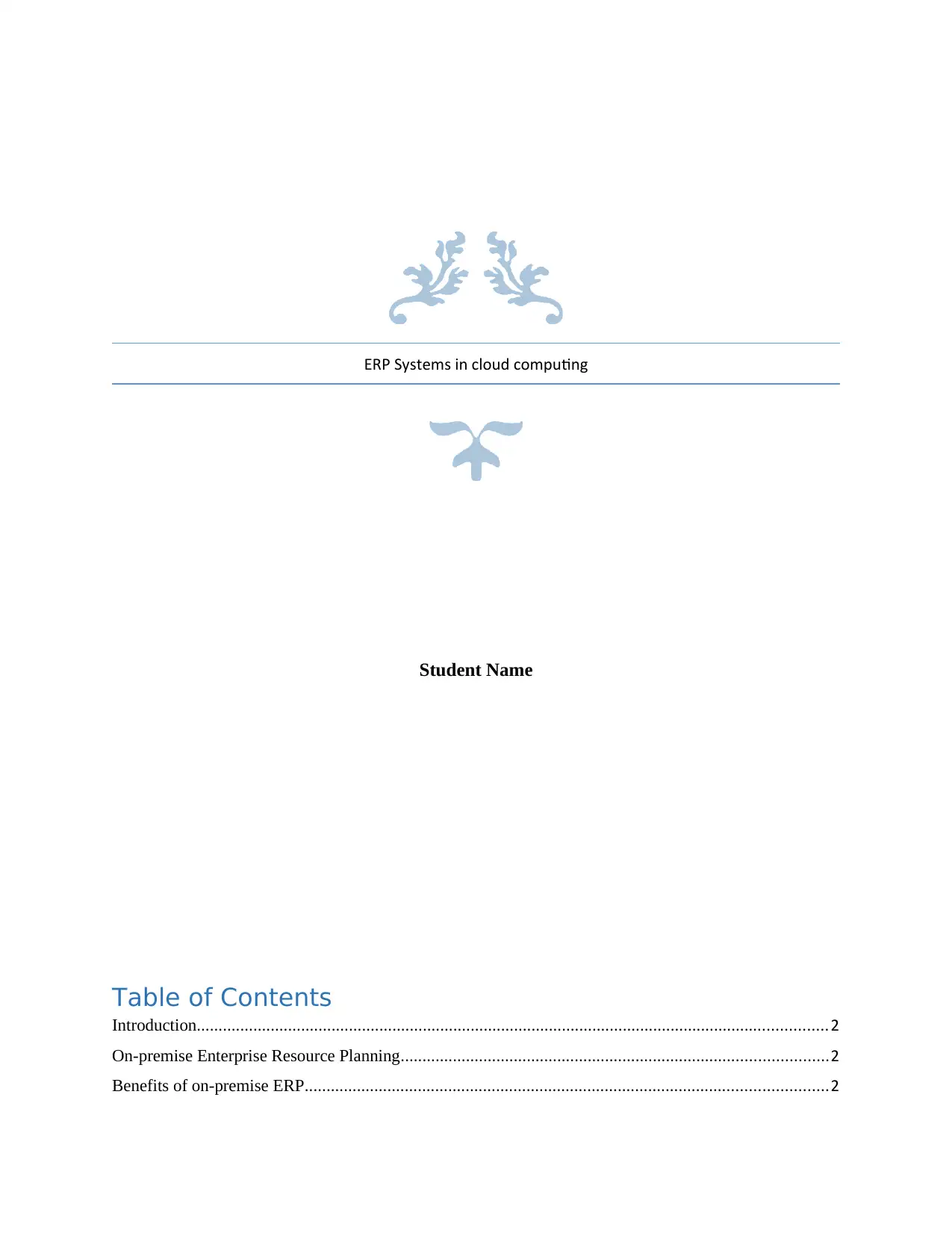
ERP Systems in cloud computing
Student Name
Table of Contents
Introduction.................................................................................................................................................2
On-premise Enterprise Resource Planning..................................................................................................2
Benefits of on-premise ERP........................................................................................................................2
Student Name
Table of Contents
Introduction.................................................................................................................................................2
On-premise Enterprise Resource Planning..................................................................................................2
Benefits of on-premise ERP........................................................................................................................2
Secure Best Marks with AI Grader
Need help grading? Try our AI Grader for instant feedback on your assignments.
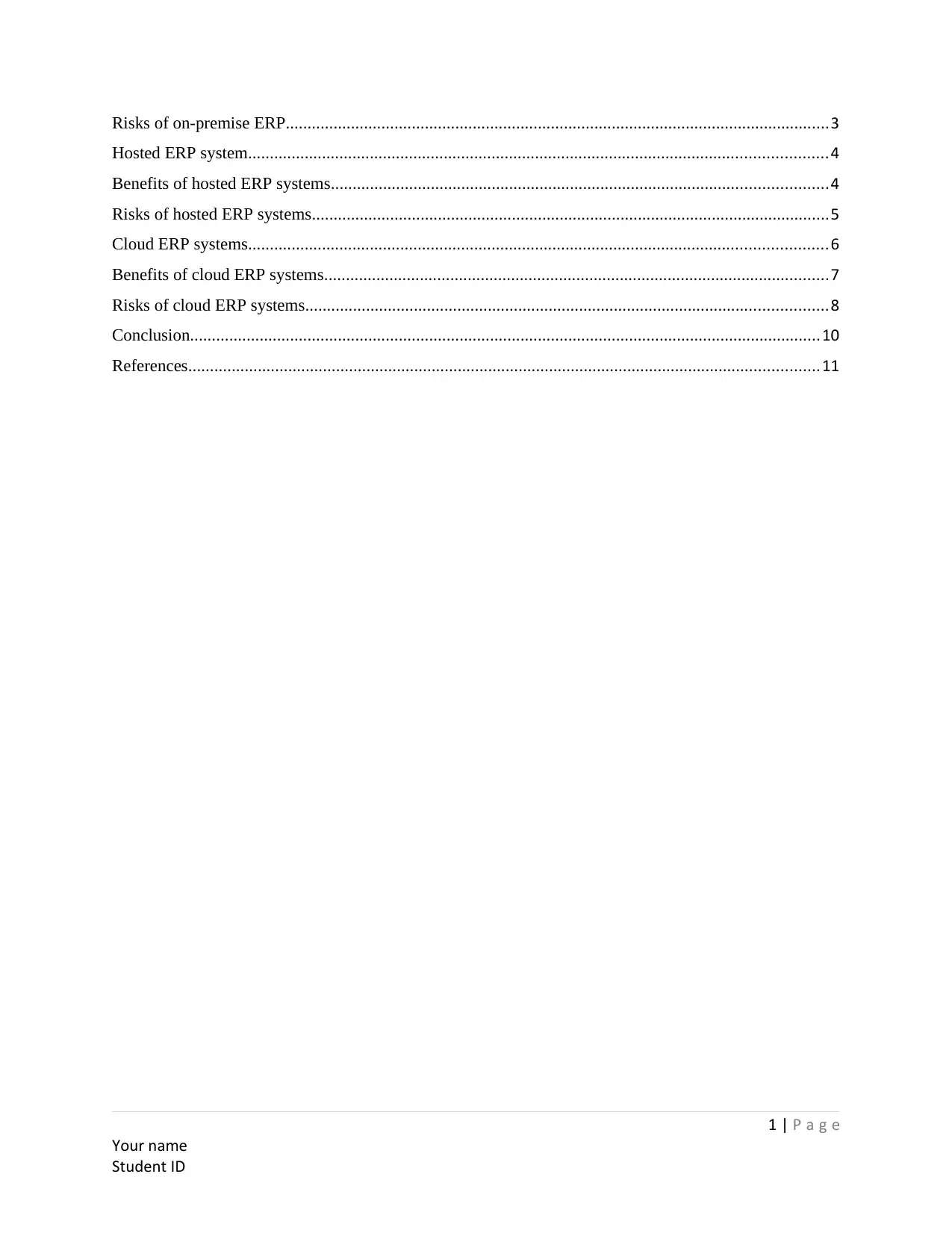
Risks of on-premise ERP.............................................................................................................................3
Hosted ERP system.....................................................................................................................................4
Benefits of hosted ERP systems..................................................................................................................4
Risks of hosted ERP systems.......................................................................................................................5
Cloud ERP systems.....................................................................................................................................6
Benefits of cloud ERP systems....................................................................................................................7
Risks of cloud ERP systems........................................................................................................................8
Conclusion.................................................................................................................................................10
References.................................................................................................................................................11
1 | P a g e
Your name
Student ID
Hosted ERP system.....................................................................................................................................4
Benefits of hosted ERP systems..................................................................................................................4
Risks of hosted ERP systems.......................................................................................................................5
Cloud ERP systems.....................................................................................................................................6
Benefits of cloud ERP systems....................................................................................................................7
Risks of cloud ERP systems........................................................................................................................8
Conclusion.................................................................................................................................................10
References.................................................................................................................................................11
1 | P a g e
Your name
Student ID
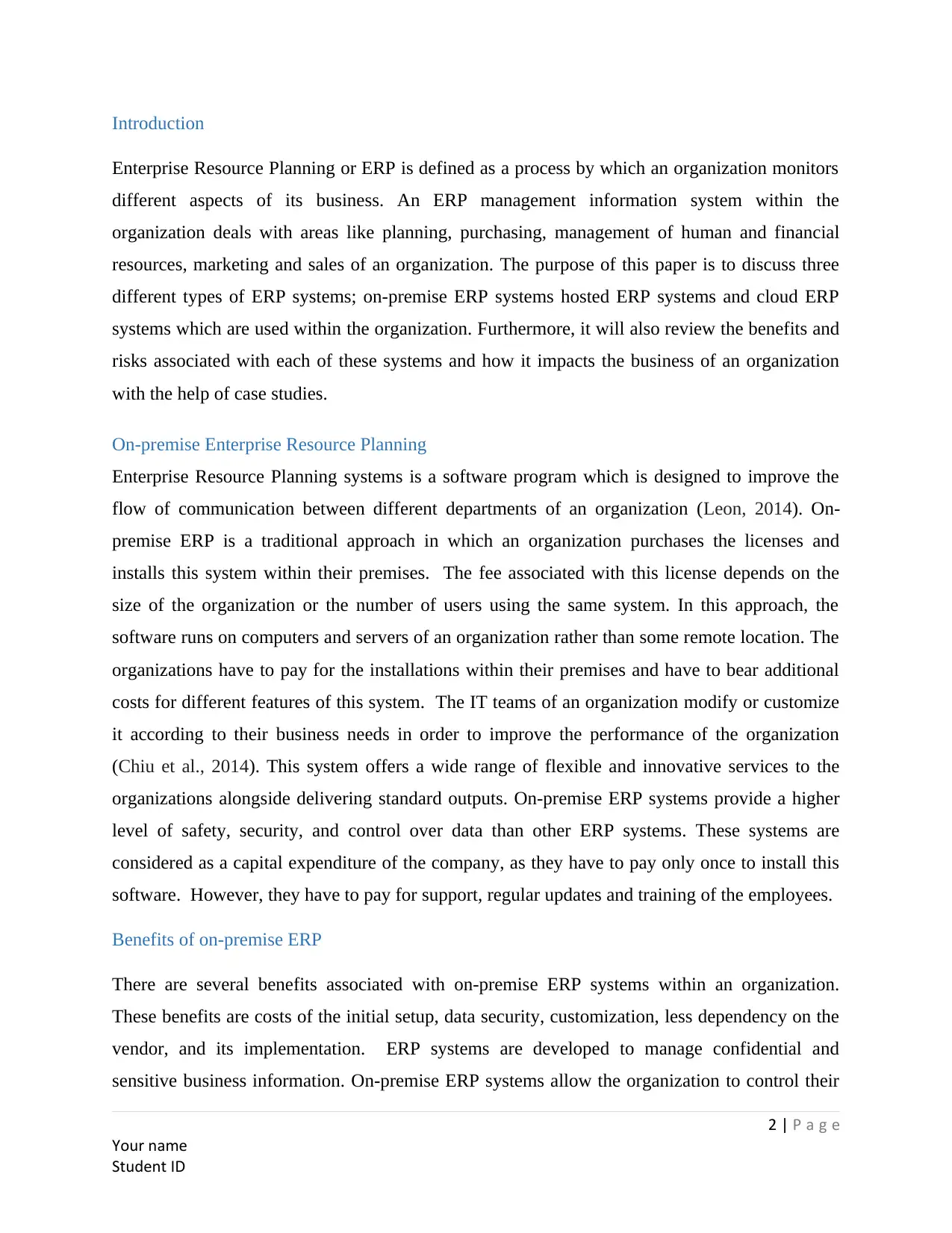
Introduction
Enterprise Resource Planning or ERP is defined as a process by which an organization monitors
different aspects of its business. An ERP management information system within the
organization deals with areas like planning, purchasing, management of human and financial
resources, marketing and sales of an organization. The purpose of this paper is to discuss three
different types of ERP systems; on-premise ERP systems hosted ERP systems and cloud ERP
systems which are used within the organization. Furthermore, it will also review the benefits and
risks associated with each of these systems and how it impacts the business of an organization
with the help of case studies.
On-premise Enterprise Resource Planning
Enterprise Resource Planning systems is a software program which is designed to improve the
flow of communication between different departments of an organization (Leon, 2014). On-
premise ERP is a traditional approach in which an organization purchases the licenses and
installs this system within their premises. The fee associated with this license depends on the
size of the organization or the number of users using the same system. In this approach, the
software runs on computers and servers of an organization rather than some remote location. The
organizations have to pay for the installations within their premises and have to bear additional
costs for different features of this system. The IT teams of an organization modify or customize
it according to their business needs in order to improve the performance of the organization
(Chiu et al., 2014). This system offers a wide range of flexible and innovative services to the
organizations alongside delivering standard outputs. On-premise ERP systems provide a higher
level of safety, security, and control over data than other ERP systems. These systems are
considered as a capital expenditure of the company, as they have to pay only once to install this
software. However, they have to pay for support, regular updates and training of the employees.
Benefits of on-premise ERP
There are several benefits associated with on-premise ERP systems within an organization.
These benefits are costs of the initial setup, data security, customization, less dependency on the
vendor, and its implementation. ERP systems are developed to manage confidential and
sensitive business information. On-premise ERP systems allow the organization to control their
2 | P a g e
Your name
Student ID
Enterprise Resource Planning or ERP is defined as a process by which an organization monitors
different aspects of its business. An ERP management information system within the
organization deals with areas like planning, purchasing, management of human and financial
resources, marketing and sales of an organization. The purpose of this paper is to discuss three
different types of ERP systems; on-premise ERP systems hosted ERP systems and cloud ERP
systems which are used within the organization. Furthermore, it will also review the benefits and
risks associated with each of these systems and how it impacts the business of an organization
with the help of case studies.
On-premise Enterprise Resource Planning
Enterprise Resource Planning systems is a software program which is designed to improve the
flow of communication between different departments of an organization (Leon, 2014). On-
premise ERP is a traditional approach in which an organization purchases the licenses and
installs this system within their premises. The fee associated with this license depends on the
size of the organization or the number of users using the same system. In this approach, the
software runs on computers and servers of an organization rather than some remote location. The
organizations have to pay for the installations within their premises and have to bear additional
costs for different features of this system. The IT teams of an organization modify or customize
it according to their business needs in order to improve the performance of the organization
(Chiu et al., 2014). This system offers a wide range of flexible and innovative services to the
organizations alongside delivering standard outputs. On-premise ERP systems provide a higher
level of safety, security, and control over data than other ERP systems. These systems are
considered as a capital expenditure of the company, as they have to pay only once to install this
software. However, they have to pay for support, regular updates and training of the employees.
Benefits of on-premise ERP
There are several benefits associated with on-premise ERP systems within an organization.
These benefits are costs of the initial setup, data security, customization, less dependency on the
vendor, and its implementation. ERP systems are developed to manage confidential and
sensitive business information. On-premise ERP systems allow the organization to control their
2 | P a g e
Your name
Student ID
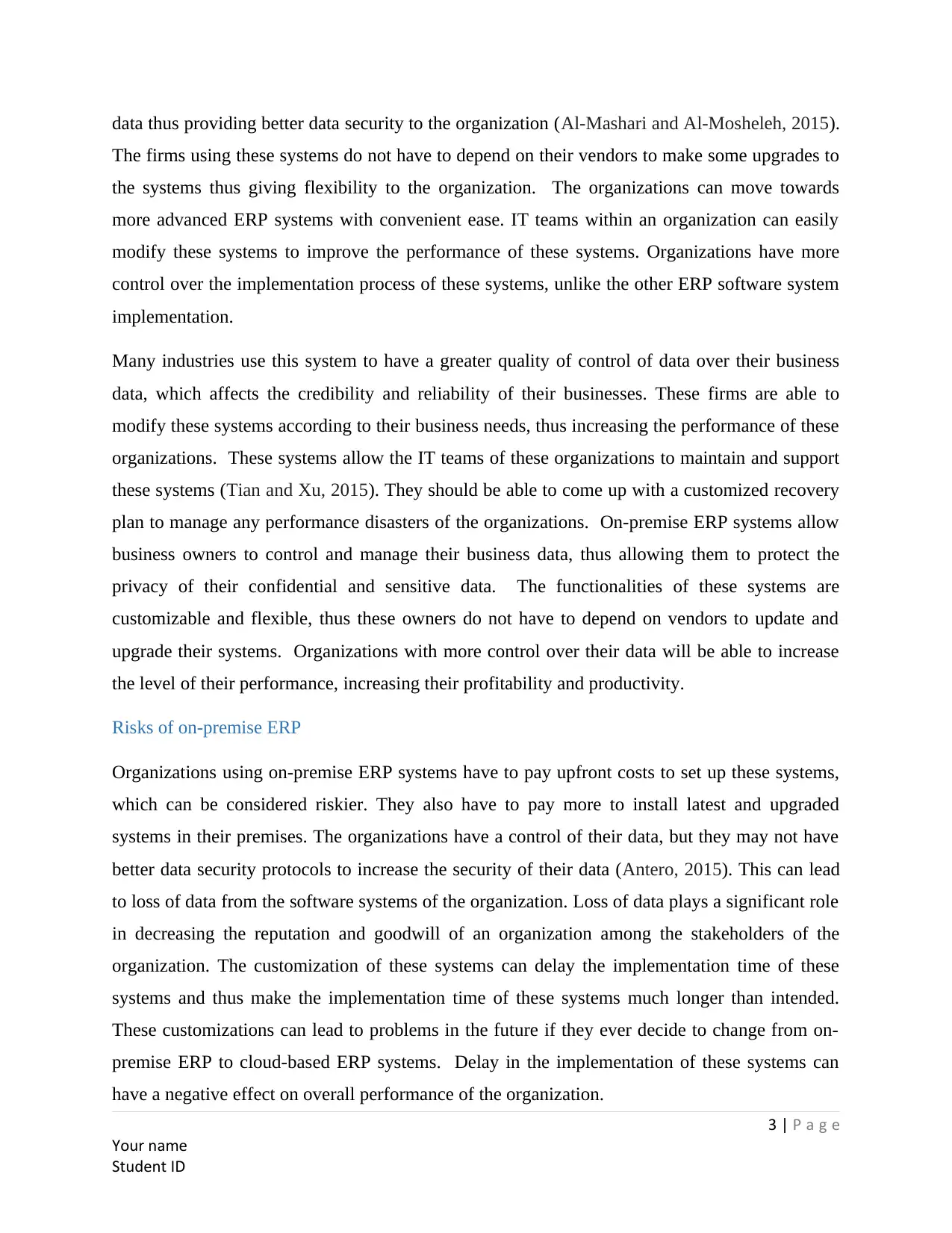
data thus providing better data security to the organization (Al-Mashari and Al-Mosheleh, 2015).
The firms using these systems do not have to depend on their vendors to make some upgrades to
the systems thus giving flexibility to the organization. The organizations can move towards
more advanced ERP systems with convenient ease. IT teams within an organization can easily
modify these systems to improve the performance of these systems. Organizations have more
control over the implementation process of these systems, unlike the other ERP software system
implementation.
Many industries use this system to have a greater quality of control of data over their business
data, which affects the credibility and reliability of their businesses. These firms are able to
modify these systems according to their business needs, thus increasing the performance of these
organizations. These systems allow the IT teams of these organizations to maintain and support
these systems (Tian and Xu, 2015). They should be able to come up with a customized recovery
plan to manage any performance disasters of the organizations. On-premise ERP systems allow
business owners to control and manage their business data, thus allowing them to protect the
privacy of their confidential and sensitive data. The functionalities of these systems are
customizable and flexible, thus these owners do not have to depend on vendors to update and
upgrade their systems. Organizations with more control over their data will be able to increase
the level of their performance, increasing their profitability and productivity.
Risks of on-premise ERP
Organizations using on-premise ERP systems have to pay upfront costs to set up these systems,
which can be considered riskier. They also have to pay more to install latest and upgraded
systems in their premises. The organizations have a control of their data, but they may not have
better data security protocols to increase the security of their data (Antero, 2015). This can lead
to loss of data from the software systems of the organization. Loss of data plays a significant role
in decreasing the reputation and goodwill of an organization among the stakeholders of the
organization. The customization of these systems can delay the implementation time of these
systems and thus make the implementation time of these systems much longer than intended.
These customizations can lead to problems in the future if they ever decide to change from on-
premise ERP to cloud-based ERP systems. Delay in the implementation of these systems can
have a negative effect on overall performance of the organization.
3 | P a g e
Your name
Student ID
The firms using these systems do not have to depend on their vendors to make some upgrades to
the systems thus giving flexibility to the organization. The organizations can move towards
more advanced ERP systems with convenient ease. IT teams within an organization can easily
modify these systems to improve the performance of these systems. Organizations have more
control over the implementation process of these systems, unlike the other ERP software system
implementation.
Many industries use this system to have a greater quality of control of data over their business
data, which affects the credibility and reliability of their businesses. These firms are able to
modify these systems according to their business needs, thus increasing the performance of these
organizations. These systems allow the IT teams of these organizations to maintain and support
these systems (Tian and Xu, 2015). They should be able to come up with a customized recovery
plan to manage any performance disasters of the organizations. On-premise ERP systems allow
business owners to control and manage their business data, thus allowing them to protect the
privacy of their confidential and sensitive data. The functionalities of these systems are
customizable and flexible, thus these owners do not have to depend on vendors to update and
upgrade their systems. Organizations with more control over their data will be able to increase
the level of their performance, increasing their profitability and productivity.
Risks of on-premise ERP
Organizations using on-premise ERP systems have to pay upfront costs to set up these systems,
which can be considered riskier. They also have to pay more to install latest and upgraded
systems in their premises. The organizations have a control of their data, but they may not have
better data security protocols to increase the security of their data (Antero, 2015). This can lead
to loss of data from the software systems of the organization. Loss of data plays a significant role
in decreasing the reputation and goodwill of an organization among the stakeholders of the
organization. The customization of these systems can delay the implementation time of these
systems and thus make the implementation time of these systems much longer than intended.
These customizations can lead to problems in the future if they ever decide to change from on-
premise ERP to cloud-based ERP systems. Delay in the implementation of these systems can
have a negative effect on overall performance of the organization.
3 | P a g e
Your name
Student ID
Secure Best Marks with AI Grader
Need help grading? Try our AI Grader for instant feedback on your assignments.
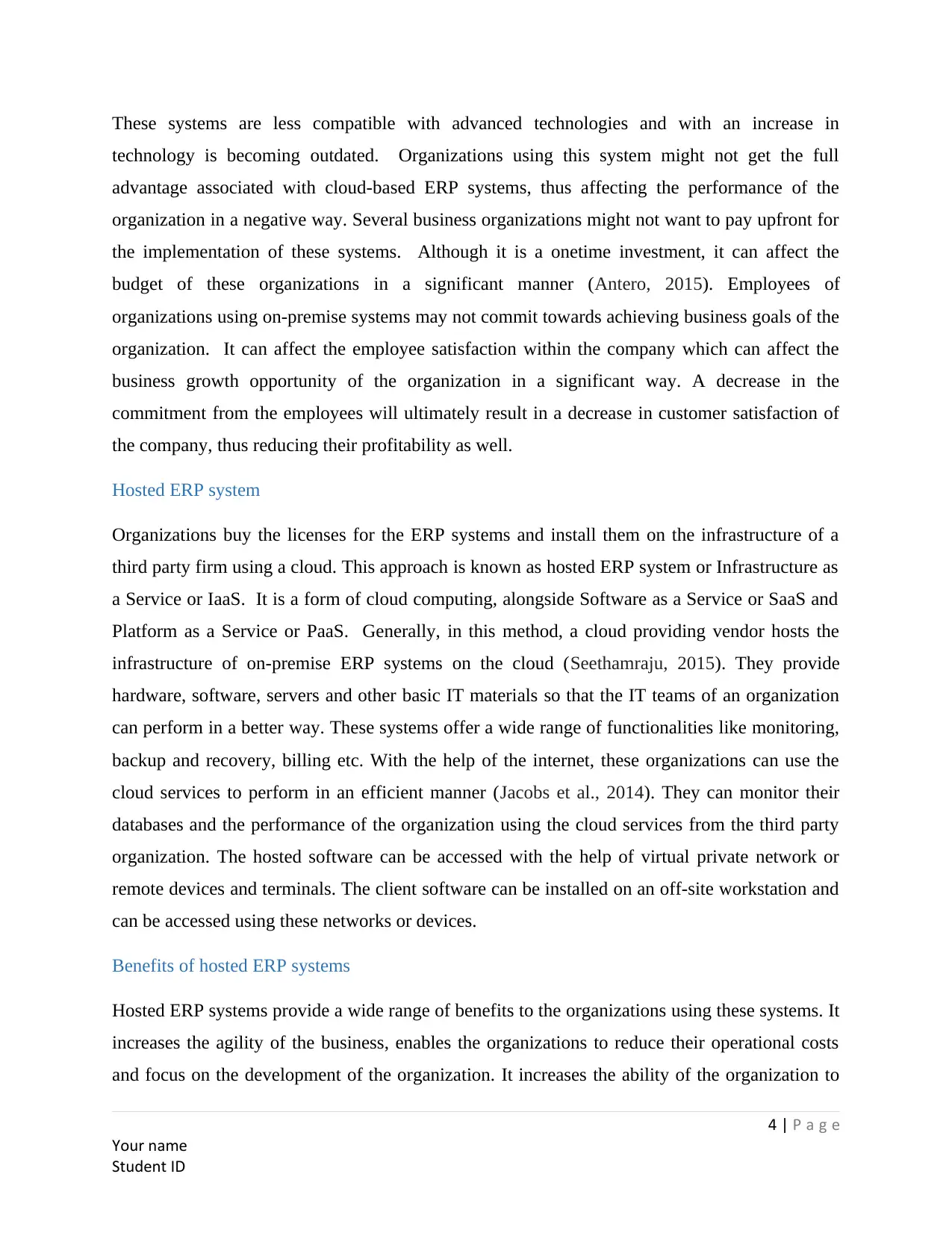
These systems are less compatible with advanced technologies and with an increase in
technology is becoming outdated. Organizations using this system might not get the full
advantage associated with cloud-based ERP systems, thus affecting the performance of the
organization in a negative way. Several business organizations might not want to pay upfront for
the implementation of these systems. Although it is a onetime investment, it can affect the
budget of these organizations in a significant manner (Antero, 2015). Employees of
organizations using on-premise systems may not commit towards achieving business goals of the
organization. It can affect the employee satisfaction within the company which can affect the
business growth opportunity of the organization in a significant way. A decrease in the
commitment from the employees will ultimately result in a decrease in customer satisfaction of
the company, thus reducing their profitability as well.
Hosted ERP system
Organizations buy the licenses for the ERP systems and install them on the infrastructure of a
third party firm using a cloud. This approach is known as hosted ERP system or Infrastructure as
a Service or IaaS. It is a form of cloud computing, alongside Software as a Service or SaaS and
Platform as a Service or PaaS. Generally, in this method, a cloud providing vendor hosts the
infrastructure of on-premise ERP systems on the cloud (Seethamraju, 2015). They provide
hardware, software, servers and other basic IT materials so that the IT teams of an organization
can perform in a better way. These systems offer a wide range of functionalities like monitoring,
backup and recovery, billing etc. With the help of the internet, these organizations can use the
cloud services to perform in an efficient manner (Jacobs et al., 2014). They can monitor their
databases and the performance of the organization using the cloud services from the third party
organization. The hosted software can be accessed with the help of virtual private network or
remote devices and terminals. The client software can be installed on an off-site workstation and
can be accessed using these networks or devices.
Benefits of hosted ERP systems
Hosted ERP systems provide a wide range of benefits to the organizations using these systems. It
increases the agility of the business, enables the organizations to reduce their operational costs
and focus on the development of the organization. It increases the ability of the organization to
4 | P a g e
Your name
Student ID
technology is becoming outdated. Organizations using this system might not get the full
advantage associated with cloud-based ERP systems, thus affecting the performance of the
organization in a negative way. Several business organizations might not want to pay upfront for
the implementation of these systems. Although it is a onetime investment, it can affect the
budget of these organizations in a significant manner (Antero, 2015). Employees of
organizations using on-premise systems may not commit towards achieving business goals of the
organization. It can affect the employee satisfaction within the company which can affect the
business growth opportunity of the organization in a significant way. A decrease in the
commitment from the employees will ultimately result in a decrease in customer satisfaction of
the company, thus reducing their profitability as well.
Hosted ERP system
Organizations buy the licenses for the ERP systems and install them on the infrastructure of a
third party firm using a cloud. This approach is known as hosted ERP system or Infrastructure as
a Service or IaaS. It is a form of cloud computing, alongside Software as a Service or SaaS and
Platform as a Service or PaaS. Generally, in this method, a cloud providing vendor hosts the
infrastructure of on-premise ERP systems on the cloud (Seethamraju, 2015). They provide
hardware, software, servers and other basic IT materials so that the IT teams of an organization
can perform in a better way. These systems offer a wide range of functionalities like monitoring,
backup and recovery, billing etc. With the help of the internet, these organizations can use the
cloud services to perform in an efficient manner (Jacobs et al., 2014). They can monitor their
databases and the performance of the organization using the cloud services from the third party
organization. The hosted software can be accessed with the help of virtual private network or
remote devices and terminals. The client software can be installed on an off-site workstation and
can be accessed using these networks or devices.
Benefits of hosted ERP systems
Hosted ERP systems provide a wide range of benefits to the organizations using these systems. It
increases the agility of the business, enables the organizations to reduce their operational costs
and focus on the development of the organization. It increases the ability of the organization to
4 | P a g e
Your name
Student ID
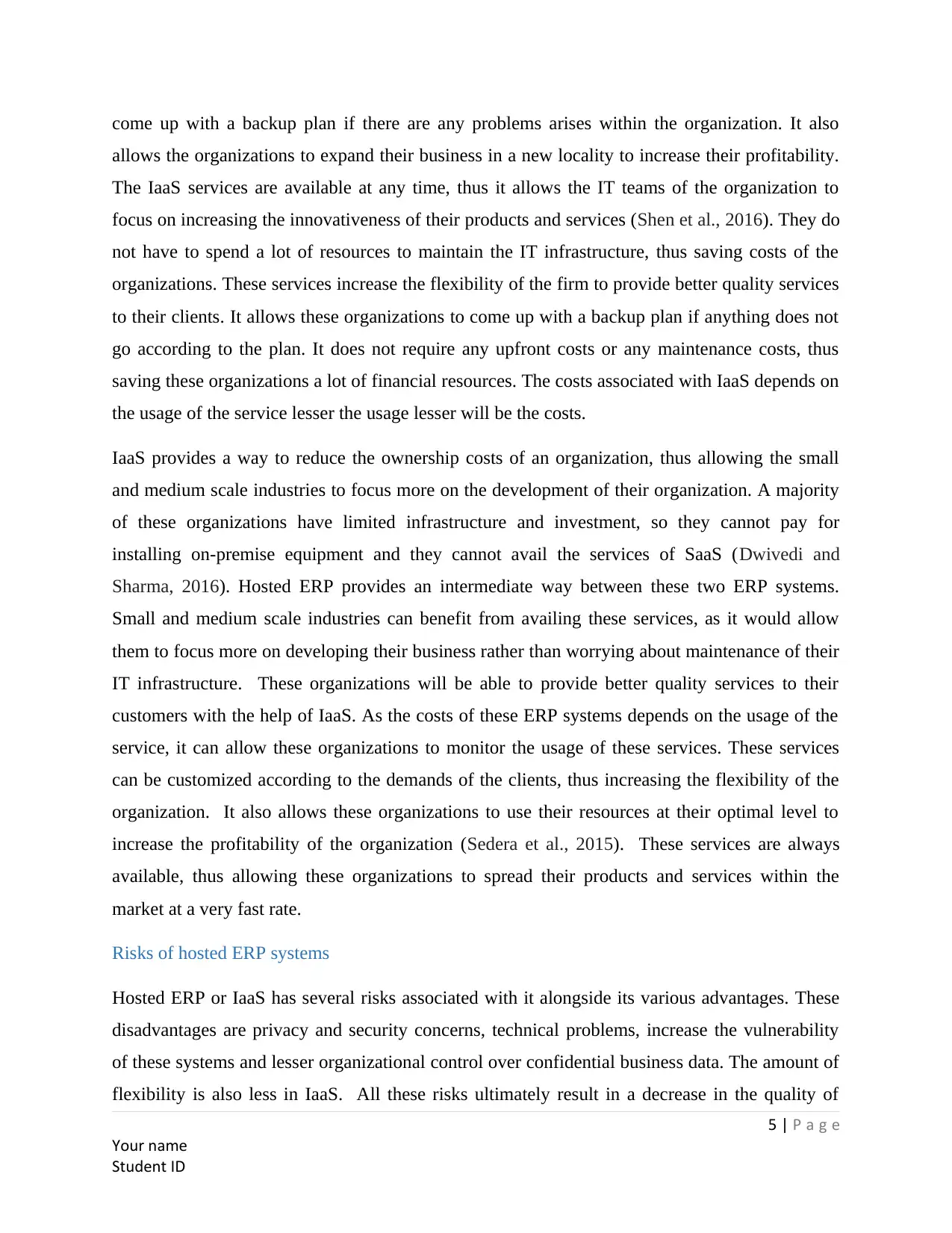
come up with a backup plan if there are any problems arises within the organization. It also
allows the organizations to expand their business in a new locality to increase their profitability.
The IaaS services are available at any time, thus it allows the IT teams of the organization to
focus on increasing the innovativeness of their products and services (Shen et al., 2016). They do
not have to spend a lot of resources to maintain the IT infrastructure, thus saving costs of the
organizations. These services increase the flexibility of the firm to provide better quality services
to their clients. It allows these organizations to come up with a backup plan if anything does not
go according to the plan. It does not require any upfront costs or any maintenance costs, thus
saving these organizations a lot of financial resources. The costs associated with IaaS depends on
the usage of the service lesser the usage lesser will be the costs.
IaaS provides a way to reduce the ownership costs of an organization, thus allowing the small
and medium scale industries to focus more on the development of their organization. A majority
of these organizations have limited infrastructure and investment, so they cannot pay for
installing on-premise equipment and they cannot avail the services of SaaS (Dwivedi and
Sharma, 2016). Hosted ERP provides an intermediate way between these two ERP systems.
Small and medium scale industries can benefit from availing these services, as it would allow
them to focus more on developing their business rather than worrying about maintenance of their
IT infrastructure. These organizations will be able to provide better quality services to their
customers with the help of IaaS. As the costs of these ERP systems depends on the usage of the
service, it can allow these organizations to monitor the usage of these services. These services
can be customized according to the demands of the clients, thus increasing the flexibility of the
organization. It also allows these organizations to use their resources at their optimal level to
increase the profitability of the organization (Sedera et al., 2015). These services are always
available, thus allowing these organizations to spread their products and services within the
market at a very fast rate.
Risks of hosted ERP systems
Hosted ERP or IaaS has several risks associated with it alongside its various advantages. These
disadvantages are privacy and security concerns, technical problems, increase the vulnerability
of these systems and lesser organizational control over confidential business data. The amount of
flexibility is also less in IaaS. All these risks ultimately result in a decrease in the quality of
5 | P a g e
Your name
Student ID
allows the organizations to expand their business in a new locality to increase their profitability.
The IaaS services are available at any time, thus it allows the IT teams of the organization to
focus on increasing the innovativeness of their products and services (Shen et al., 2016). They do
not have to spend a lot of resources to maintain the IT infrastructure, thus saving costs of the
organizations. These services increase the flexibility of the firm to provide better quality services
to their clients. It allows these organizations to come up with a backup plan if anything does not
go according to the plan. It does not require any upfront costs or any maintenance costs, thus
saving these organizations a lot of financial resources. The costs associated with IaaS depends on
the usage of the service lesser the usage lesser will be the costs.
IaaS provides a way to reduce the ownership costs of an organization, thus allowing the small
and medium scale industries to focus more on the development of their organization. A majority
of these organizations have limited infrastructure and investment, so they cannot pay for
installing on-premise equipment and they cannot avail the services of SaaS (Dwivedi and
Sharma, 2016). Hosted ERP provides an intermediate way between these two ERP systems.
Small and medium scale industries can benefit from availing these services, as it would allow
them to focus more on developing their business rather than worrying about maintenance of their
IT infrastructure. These organizations will be able to provide better quality services to their
customers with the help of IaaS. As the costs of these ERP systems depends on the usage of the
service, it can allow these organizations to monitor the usage of these services. These services
can be customized according to the demands of the clients, thus increasing the flexibility of the
organization. It also allows these organizations to use their resources at their optimal level to
increase the profitability of the organization (Sedera et al., 2015). These services are always
available, thus allowing these organizations to spread their products and services within the
market at a very fast rate.
Risks of hosted ERP systems
Hosted ERP or IaaS has several risks associated with it alongside its various advantages. These
disadvantages are privacy and security concerns, technical problems, increase the vulnerability
of these systems and lesser organizational control over confidential business data. The amount of
flexibility is also less in IaaS. All these risks ultimately result in a decrease in the quality of
5 | P a g e
Your name
Student ID
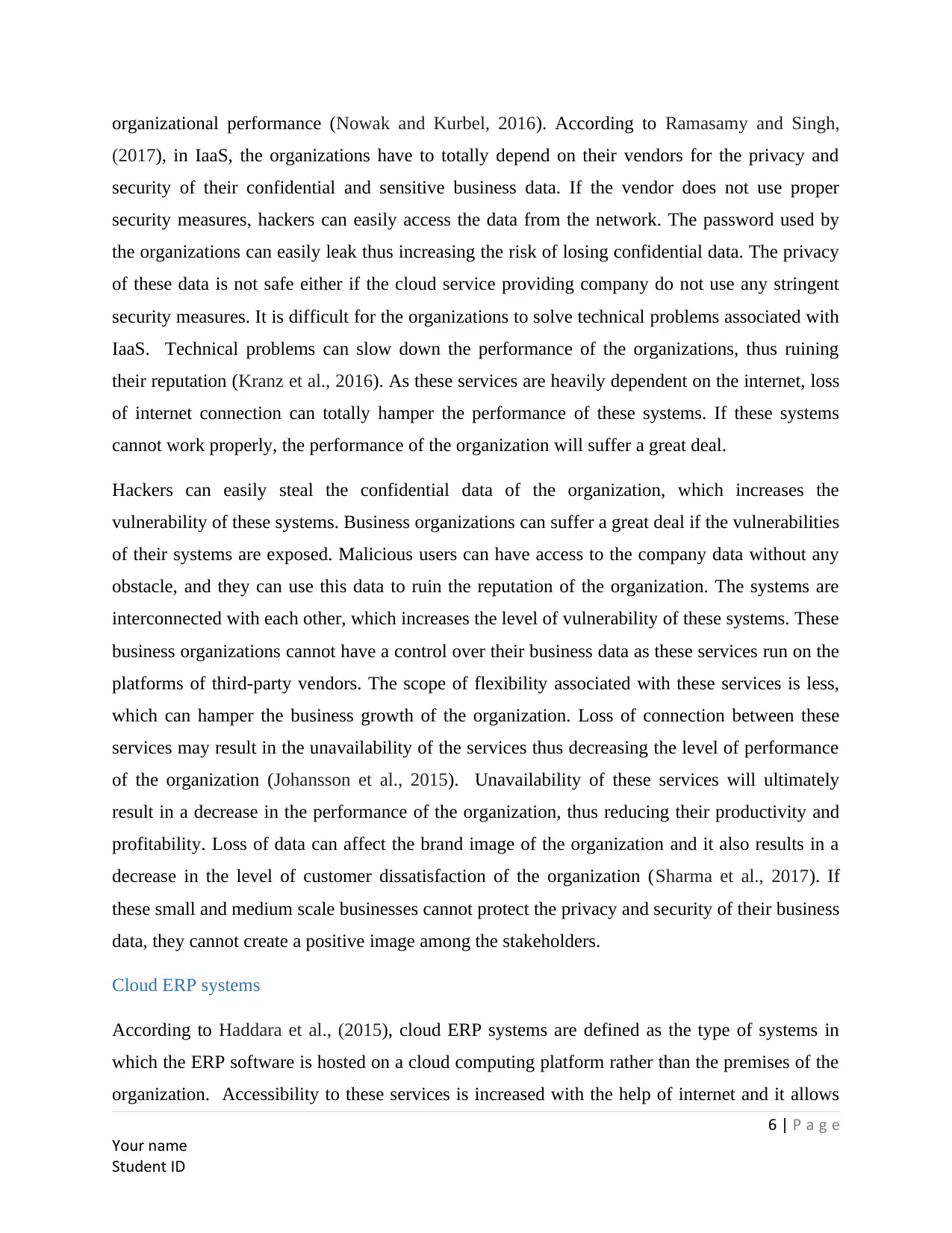
organizational performance (Nowak and Kurbel, 2016). According to Ramasamy and Singh,
(2017), in IaaS, the organizations have to totally depend on their vendors for the privacy and
security of their confidential and sensitive business data. If the vendor does not use proper
security measures, hackers can easily access the data from the network. The password used by
the organizations can easily leak thus increasing the risk of losing confidential data. The privacy
of these data is not safe either if the cloud service providing company do not use any stringent
security measures. It is difficult for the organizations to solve technical problems associated with
IaaS. Technical problems can slow down the performance of the organizations, thus ruining
their reputation (Kranz et al., 2016). As these services are heavily dependent on the internet, loss
of internet connection can totally hamper the performance of these systems. If these systems
cannot work properly, the performance of the organization will suffer a great deal.
Hackers can easily steal the confidential data of the organization, which increases the
vulnerability of these systems. Business organizations can suffer a great deal if the vulnerabilities
of their systems are exposed. Malicious users can have access to the company data without any
obstacle, and they can use this data to ruin the reputation of the organization. The systems are
interconnected with each other, which increases the level of vulnerability of these systems. These
business organizations cannot have a control over their business data as these services run on the
platforms of third-party vendors. The scope of flexibility associated with these services is less,
which can hamper the business growth of the organization. Loss of connection between these
services may result in the unavailability of the services thus decreasing the level of performance
of the organization (Johansson et al., 2015). Unavailability of these services will ultimately
result in a decrease in the performance of the organization, thus reducing their productivity and
profitability. Loss of data can affect the brand image of the organization and it also results in a
decrease in the level of customer dissatisfaction of the organization (Sharma et al., 2017). If
these small and medium scale businesses cannot protect the privacy and security of their business
data, they cannot create a positive image among the stakeholders.
Cloud ERP systems
According to Haddara et al., (2015), cloud ERP systems are defined as the type of systems in
which the ERP software is hosted on a cloud computing platform rather than the premises of the
organization. Accessibility to these services is increased with the help of internet and it allows
6 | P a g e
Your name
Student ID
(2017), in IaaS, the organizations have to totally depend on their vendors for the privacy and
security of their confidential and sensitive business data. If the vendor does not use proper
security measures, hackers can easily access the data from the network. The password used by
the organizations can easily leak thus increasing the risk of losing confidential data. The privacy
of these data is not safe either if the cloud service providing company do not use any stringent
security measures. It is difficult for the organizations to solve technical problems associated with
IaaS. Technical problems can slow down the performance of the organizations, thus ruining
their reputation (Kranz et al., 2016). As these services are heavily dependent on the internet, loss
of internet connection can totally hamper the performance of these systems. If these systems
cannot work properly, the performance of the organization will suffer a great deal.
Hackers can easily steal the confidential data of the organization, which increases the
vulnerability of these systems. Business organizations can suffer a great deal if the vulnerabilities
of their systems are exposed. Malicious users can have access to the company data without any
obstacle, and they can use this data to ruin the reputation of the organization. The systems are
interconnected with each other, which increases the level of vulnerability of these systems. These
business organizations cannot have a control over their business data as these services run on the
platforms of third-party vendors. The scope of flexibility associated with these services is less,
which can hamper the business growth of the organization. Loss of connection between these
services may result in the unavailability of the services thus decreasing the level of performance
of the organization (Johansson et al., 2015). Unavailability of these services will ultimately
result in a decrease in the performance of the organization, thus reducing their productivity and
profitability. Loss of data can affect the brand image of the organization and it also results in a
decrease in the level of customer dissatisfaction of the organization (Sharma et al., 2017). If
these small and medium scale businesses cannot protect the privacy and security of their business
data, they cannot create a positive image among the stakeholders.
Cloud ERP systems
According to Haddara et al., (2015), cloud ERP systems are defined as the type of systems in
which the ERP software is hosted on a cloud computing platform rather than the premises of the
organization. Accessibility to these services is increased with the help of internet and it allows
6 | P a g e
Your name
Student ID
Paraphrase This Document
Need a fresh take? Get an instant paraphrase of this document with our AI Paraphraser
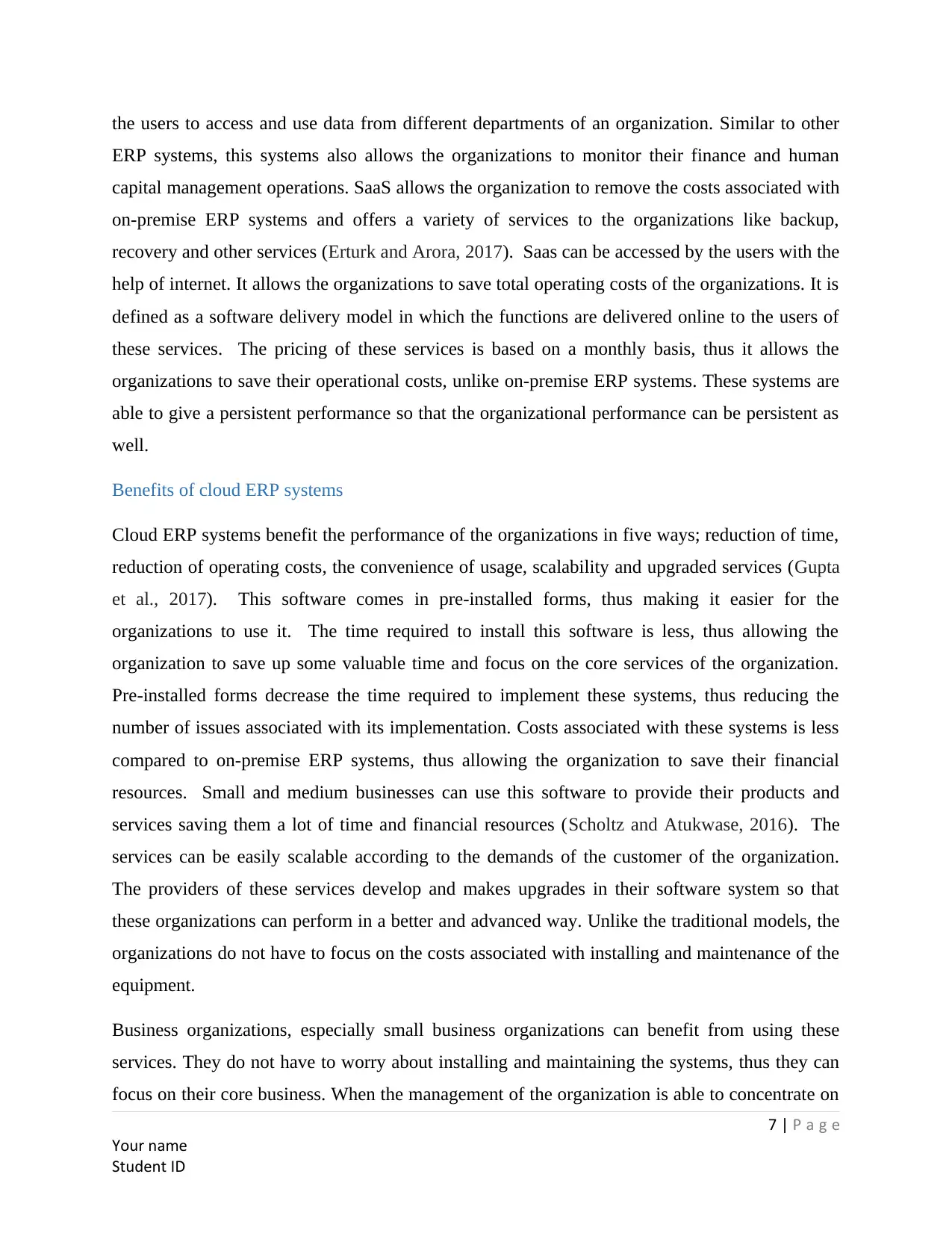
the users to access and use data from different departments of an organization. Similar to other
ERP systems, this systems also allows the organizations to monitor their finance and human
capital management operations. SaaS allows the organization to remove the costs associated with
on-premise ERP systems and offers a variety of services to the organizations like backup,
recovery and other services (Erturk and Arora, 2017). Saas can be accessed by the users with the
help of internet. It allows the organizations to save total operating costs of the organizations. It is
defined as a software delivery model in which the functions are delivered online to the users of
these services. The pricing of these services is based on a monthly basis, thus it allows the
organizations to save their operational costs, unlike on-premise ERP systems. These systems are
able to give a persistent performance so that the organizational performance can be persistent as
well.
Benefits of cloud ERP systems
Cloud ERP systems benefit the performance of the organizations in five ways; reduction of time,
reduction of operating costs, the convenience of usage, scalability and upgraded services (Gupta
et al., 2017). This software comes in pre-installed forms, thus making it easier for the
organizations to use it. The time required to install this software is less, thus allowing the
organization to save up some valuable time and focus on the core services of the organization.
Pre-installed forms decrease the time required to implement these systems, thus reducing the
number of issues associated with its implementation. Costs associated with these systems is less
compared to on-premise ERP systems, thus allowing the organization to save their financial
resources. Small and medium businesses can use this software to provide their products and
services saving them a lot of time and financial resources (Scholtz and Atukwase, 2016). The
services can be easily scalable according to the demands of the customer of the organization.
The providers of these services develop and makes upgrades in their software system so that
these organizations can perform in a better and advanced way. Unlike the traditional models, the
organizations do not have to focus on the costs associated with installing and maintenance of the
equipment.
Business organizations, especially small business organizations can benefit from using these
services. They do not have to worry about installing and maintaining the systems, thus they can
focus on their core business. When the management of the organization is able to concentrate on
7 | P a g e
Your name
Student ID
ERP systems, this systems also allows the organizations to monitor their finance and human
capital management operations. SaaS allows the organization to remove the costs associated with
on-premise ERP systems and offers a variety of services to the organizations like backup,
recovery and other services (Erturk and Arora, 2017). Saas can be accessed by the users with the
help of internet. It allows the organizations to save total operating costs of the organizations. It is
defined as a software delivery model in which the functions are delivered online to the users of
these services. The pricing of these services is based on a monthly basis, thus it allows the
organizations to save their operational costs, unlike on-premise ERP systems. These systems are
able to give a persistent performance so that the organizational performance can be persistent as
well.
Benefits of cloud ERP systems
Cloud ERP systems benefit the performance of the organizations in five ways; reduction of time,
reduction of operating costs, the convenience of usage, scalability and upgraded services (Gupta
et al., 2017). This software comes in pre-installed forms, thus making it easier for the
organizations to use it. The time required to install this software is less, thus allowing the
organization to save up some valuable time and focus on the core services of the organization.
Pre-installed forms decrease the time required to implement these systems, thus reducing the
number of issues associated with its implementation. Costs associated with these systems is less
compared to on-premise ERP systems, thus allowing the organization to save their financial
resources. Small and medium businesses can use this software to provide their products and
services saving them a lot of time and financial resources (Scholtz and Atukwase, 2016). The
services can be easily scalable according to the demands of the customer of the organization.
The providers of these services develop and makes upgrades in their software system so that
these organizations can perform in a better and advanced way. Unlike the traditional models, the
organizations do not have to focus on the costs associated with installing and maintenance of the
equipment.
Business organizations, especially small business organizations can benefit from using these
services. They do not have to worry about installing and maintaining the systems, thus they can
focus on their core business. When the management of the organization is able to concentrate on
7 | P a g e
Your name
Student ID
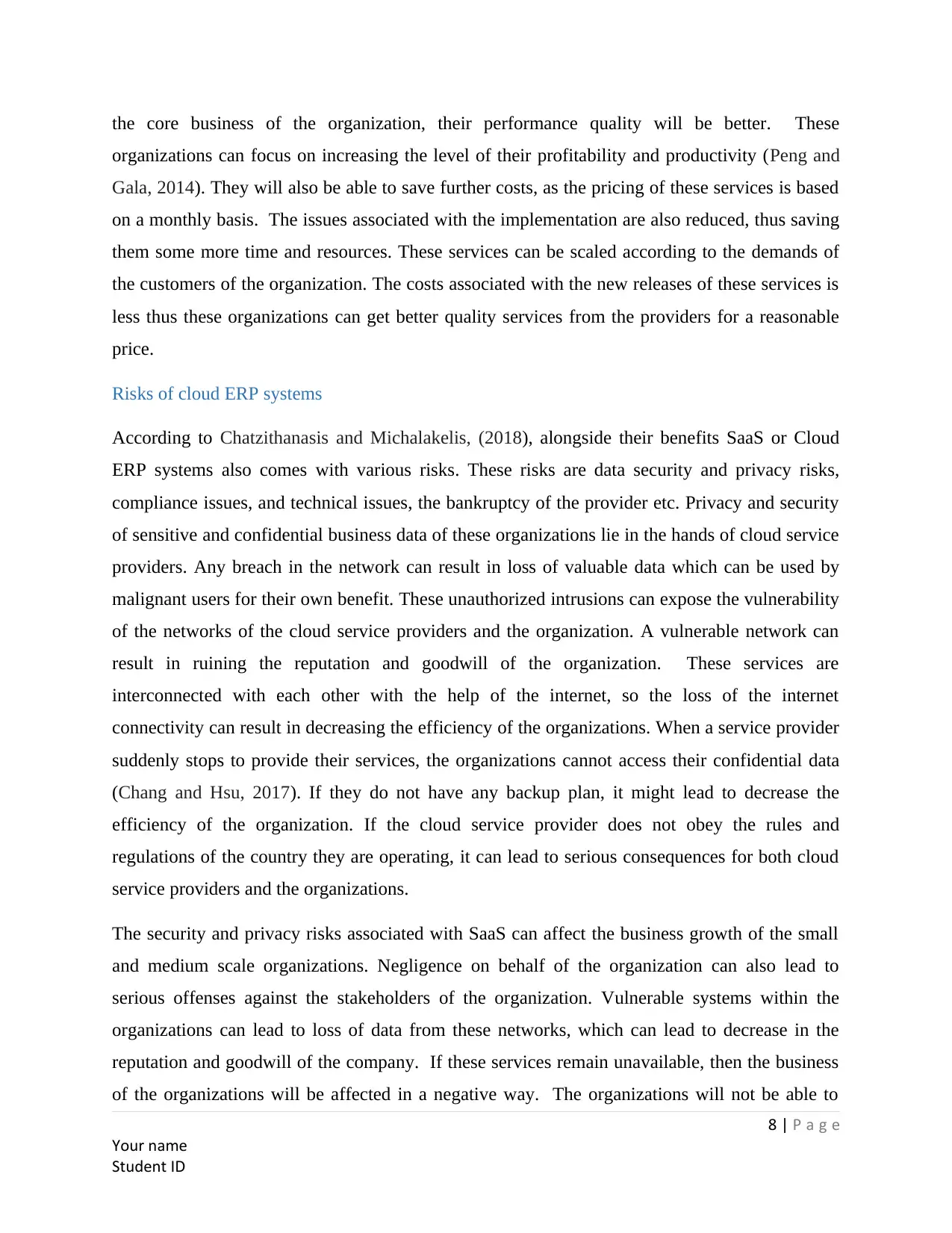
the core business of the organization, their performance quality will be better. These
organizations can focus on increasing the level of their profitability and productivity (Peng and
Gala, 2014). They will also be able to save further costs, as the pricing of these services is based
on a monthly basis. The issues associated with the implementation are also reduced, thus saving
them some more time and resources. These services can be scaled according to the demands of
the customers of the organization. The costs associated with the new releases of these services is
less thus these organizations can get better quality services from the providers for a reasonable
price.
Risks of cloud ERP systems
According to Chatzithanasis and Michalakelis, (2018), alongside their benefits SaaS or Cloud
ERP systems also comes with various risks. These risks are data security and privacy risks,
compliance issues, and technical issues, the bankruptcy of the provider etc. Privacy and security
of sensitive and confidential business data of these organizations lie in the hands of cloud service
providers. Any breach in the network can result in loss of valuable data which can be used by
malignant users for their own benefit. These unauthorized intrusions can expose the vulnerability
of the networks of the cloud service providers and the organization. A vulnerable network can
result in ruining the reputation and goodwill of the organization. These services are
interconnected with each other with the help of the internet, so the loss of the internet
connectivity can result in decreasing the efficiency of the organizations. When a service provider
suddenly stops to provide their services, the organizations cannot access their confidential data
(Chang and Hsu, 2017). If they do not have any backup plan, it might lead to decrease the
efficiency of the organization. If the cloud service provider does not obey the rules and
regulations of the country they are operating, it can lead to serious consequences for both cloud
service providers and the organizations.
The security and privacy risks associated with SaaS can affect the business growth of the small
and medium scale organizations. Negligence on behalf of the organization can also lead to
serious offenses against the stakeholders of the organization. Vulnerable systems within the
organizations can lead to loss of data from these networks, which can lead to decrease in the
reputation and goodwill of the company. If these services remain unavailable, then the business
of the organizations will be affected in a negative way. The organizations will not be able to
8 | P a g e
Your name
Student ID
organizations can focus on increasing the level of their profitability and productivity (Peng and
Gala, 2014). They will also be able to save further costs, as the pricing of these services is based
on a monthly basis. The issues associated with the implementation are also reduced, thus saving
them some more time and resources. These services can be scaled according to the demands of
the customers of the organization. The costs associated with the new releases of these services is
less thus these organizations can get better quality services from the providers for a reasonable
price.
Risks of cloud ERP systems
According to Chatzithanasis and Michalakelis, (2018), alongside their benefits SaaS or Cloud
ERP systems also comes with various risks. These risks are data security and privacy risks,
compliance issues, and technical issues, the bankruptcy of the provider etc. Privacy and security
of sensitive and confidential business data of these organizations lie in the hands of cloud service
providers. Any breach in the network can result in loss of valuable data which can be used by
malignant users for their own benefit. These unauthorized intrusions can expose the vulnerability
of the networks of the cloud service providers and the organization. A vulnerable network can
result in ruining the reputation and goodwill of the organization. These services are
interconnected with each other with the help of the internet, so the loss of the internet
connectivity can result in decreasing the efficiency of the organizations. When a service provider
suddenly stops to provide their services, the organizations cannot access their confidential data
(Chang and Hsu, 2017). If they do not have any backup plan, it might lead to decrease the
efficiency of the organization. If the cloud service provider does not obey the rules and
regulations of the country they are operating, it can lead to serious consequences for both cloud
service providers and the organizations.
The security and privacy risks associated with SaaS can affect the business growth of the small
and medium scale organizations. Negligence on behalf of the organization can also lead to
serious offenses against the stakeholders of the organization. Vulnerable systems within the
organizations can lead to loss of data from these networks, which can lead to decrease in the
reputation and goodwill of the company. If these services remain unavailable, then the business
of the organizations will be affected in a negative way. The organizations will not be able to
8 | P a g e
Your name
Student ID
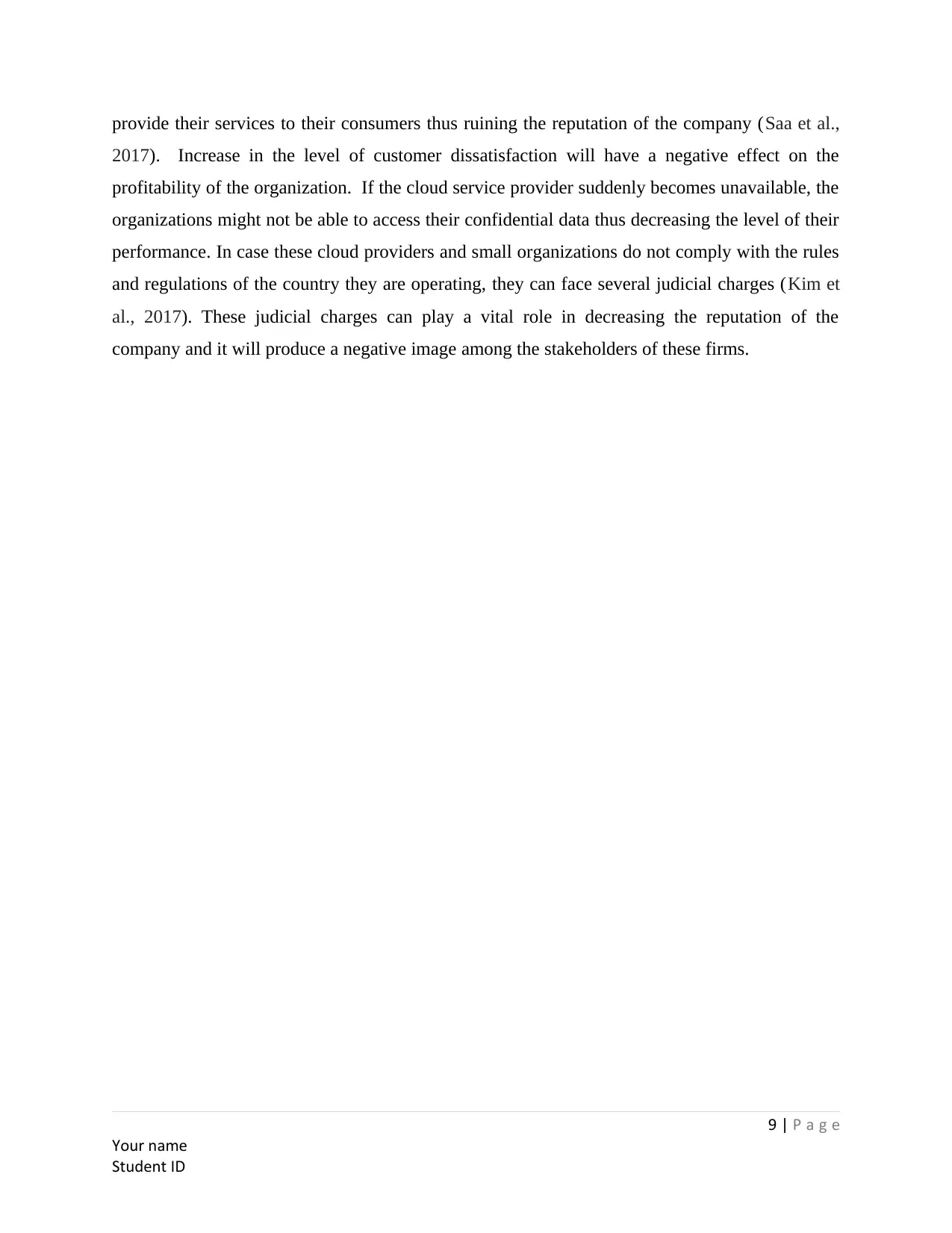
provide their services to their consumers thus ruining the reputation of the company (Saa et al.,
2017). Increase in the level of customer dissatisfaction will have a negative effect on the
profitability of the organization. If the cloud service provider suddenly becomes unavailable, the
organizations might not be able to access their confidential data thus decreasing the level of their
performance. In case these cloud providers and small organizations do not comply with the rules
and regulations of the country they are operating, they can face several judicial charges (Kim et
al., 2017). These judicial charges can play a vital role in decreasing the reputation of the
company and it will produce a negative image among the stakeholders of these firms.
9 | P a g e
Your name
Student ID
2017). Increase in the level of customer dissatisfaction will have a negative effect on the
profitability of the organization. If the cloud service provider suddenly becomes unavailable, the
organizations might not be able to access their confidential data thus decreasing the level of their
performance. In case these cloud providers and small organizations do not comply with the rules
and regulations of the country they are operating, they can face several judicial charges (Kim et
al., 2017). These judicial charges can play a vital role in decreasing the reputation of the
company and it will produce a negative image among the stakeholders of these firms.
9 | P a g e
Your name
Student ID
Secure Best Marks with AI Grader
Need help grading? Try our AI Grader for instant feedback on your assignments.
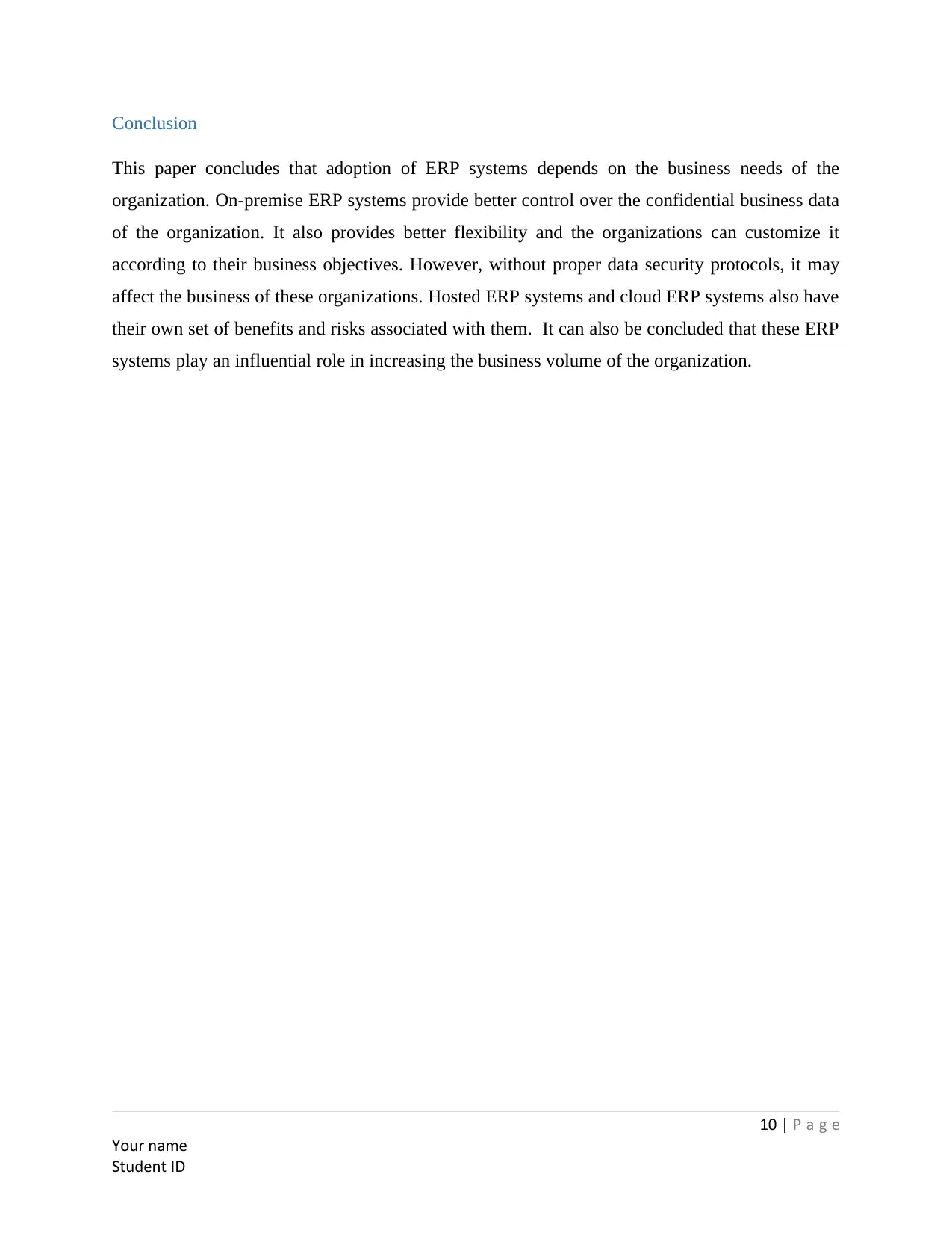
Conclusion
This paper concludes that adoption of ERP systems depends on the business needs of the
organization. On-premise ERP systems provide better control over the confidential business data
of the organization. It also provides better flexibility and the organizations can customize it
according to their business objectives. However, without proper data security protocols, it may
affect the business of these organizations. Hosted ERP systems and cloud ERP systems also have
their own set of benefits and risks associated with them. It can also be concluded that these ERP
systems play an influential role in increasing the business volume of the organization.
10 | P a g e
Your name
Student ID
This paper concludes that adoption of ERP systems depends on the business needs of the
organization. On-premise ERP systems provide better control over the confidential business data
of the organization. It also provides better flexibility and the organizations can customize it
according to their business objectives. However, without proper data security protocols, it may
affect the business of these organizations. Hosted ERP systems and cloud ERP systems also have
their own set of benefits and risks associated with them. It can also be concluded that these ERP
systems play an influential role in increasing the business volume of the organization.
10 | P a g e
Your name
Student ID
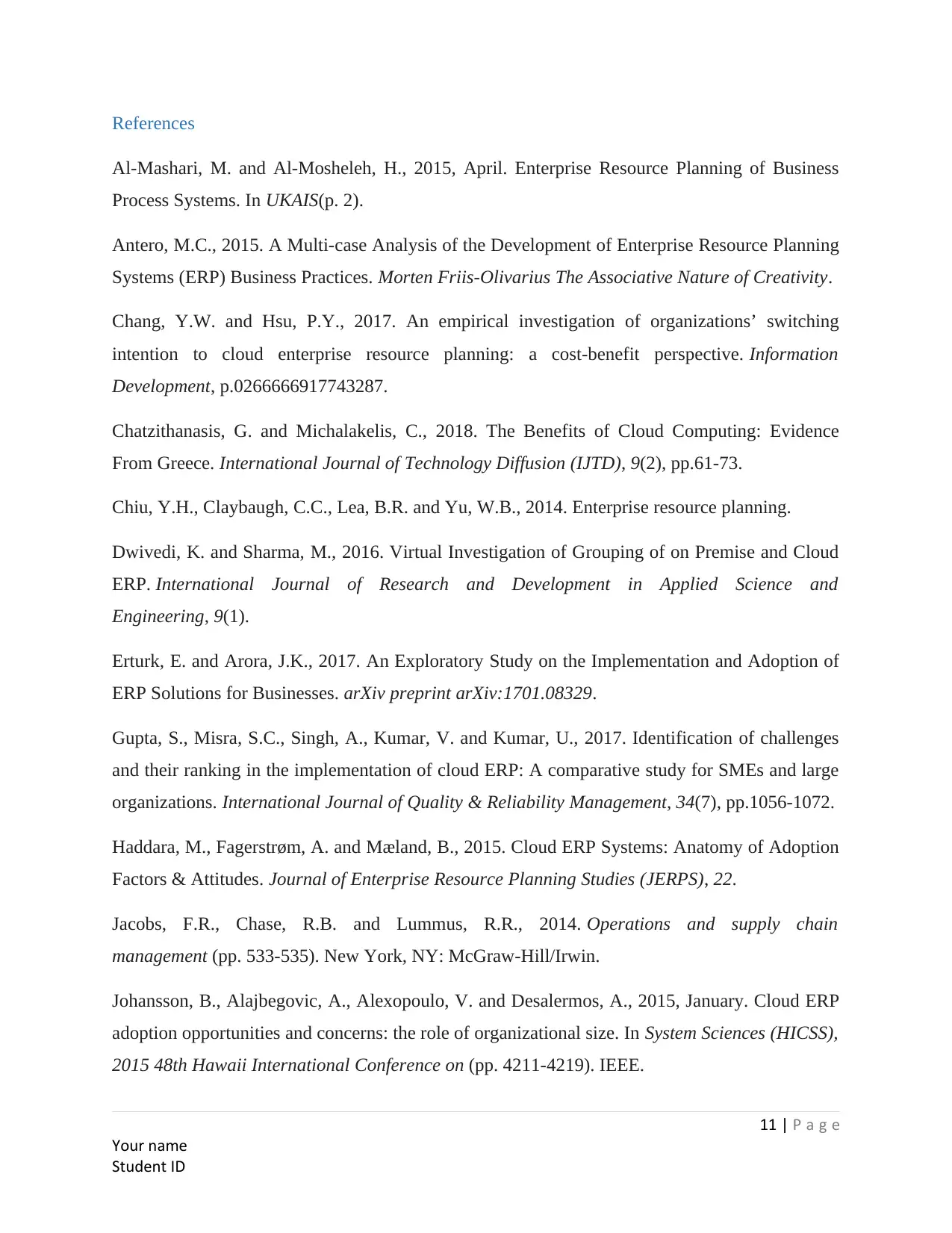
References
Al-Mashari, M. and Al-Mosheleh, H., 2015, April. Enterprise Resource Planning of Business
Process Systems. In UKAIS(p. 2).
Antero, M.C., 2015. A Multi-case Analysis of the Development of Enterprise Resource Planning
Systems (ERP) Business Practices. Morten Friis-Olivarius The Associative Nature of Creativity.
Chang, Y.W. and Hsu, P.Y., 2017. An empirical investigation of organizations’ switching
intention to cloud enterprise resource planning: a cost-benefit perspective. Information
Development, p.0266666917743287.
Chatzithanasis, G. and Michalakelis, C., 2018. The Benefits of Cloud Computing: Evidence
From Greece. International Journal of Technology Diffusion (IJTD), 9(2), pp.61-73.
Chiu, Y.H., Claybaugh, C.C., Lea, B.R. and Yu, W.B., 2014. Enterprise resource planning.
Dwivedi, K. and Sharma, M., 2016. Virtual Investigation of Grouping of on Premise and Cloud
ERP. International Journal of Research and Development in Applied Science and
Engineering, 9(1).
Erturk, E. and Arora, J.K., 2017. An Exploratory Study on the Implementation and Adoption of
ERP Solutions for Businesses. arXiv preprint arXiv:1701.08329.
Gupta, S., Misra, S.C., Singh, A., Kumar, V. and Kumar, U., 2017. Identification of challenges
and their ranking in the implementation of cloud ERP: A comparative study for SMEs and large
organizations. International Journal of Quality & Reliability Management, 34(7), pp.1056-1072.
Haddara, M., Fagerstrøm, A. and Mæland, B., 2015. Cloud ERP Systems: Anatomy of Adoption
Factors & Attitudes. Journal of Enterprise Resource Planning Studies (JERPS), 22.
Jacobs, F.R., Chase, R.B. and Lummus, R.R., 2014. Operations and supply chain
management (pp. 533-535). New York, NY: McGraw-Hill/Irwin.
Johansson, B., Alajbegovic, A., Alexopoulo, V. and Desalermos, A., 2015, January. Cloud ERP
adoption opportunities and concerns: the role of organizational size. In System Sciences (HICSS),
2015 48th Hawaii International Conference on (pp. 4211-4219). IEEE.
11 | P a g e
Your name
Student ID
Al-Mashari, M. and Al-Mosheleh, H., 2015, April. Enterprise Resource Planning of Business
Process Systems. In UKAIS(p. 2).
Antero, M.C., 2015. A Multi-case Analysis of the Development of Enterprise Resource Planning
Systems (ERP) Business Practices. Morten Friis-Olivarius The Associative Nature of Creativity.
Chang, Y.W. and Hsu, P.Y., 2017. An empirical investigation of organizations’ switching
intention to cloud enterprise resource planning: a cost-benefit perspective. Information
Development, p.0266666917743287.
Chatzithanasis, G. and Michalakelis, C., 2018. The Benefits of Cloud Computing: Evidence
From Greece. International Journal of Technology Diffusion (IJTD), 9(2), pp.61-73.
Chiu, Y.H., Claybaugh, C.C., Lea, B.R. and Yu, W.B., 2014. Enterprise resource planning.
Dwivedi, K. and Sharma, M., 2016. Virtual Investigation of Grouping of on Premise and Cloud
ERP. International Journal of Research and Development in Applied Science and
Engineering, 9(1).
Erturk, E. and Arora, J.K., 2017. An Exploratory Study on the Implementation and Adoption of
ERP Solutions for Businesses. arXiv preprint arXiv:1701.08329.
Gupta, S., Misra, S.C., Singh, A., Kumar, V. and Kumar, U., 2017. Identification of challenges
and their ranking in the implementation of cloud ERP: A comparative study for SMEs and large
organizations. International Journal of Quality & Reliability Management, 34(7), pp.1056-1072.
Haddara, M., Fagerstrøm, A. and Mæland, B., 2015. Cloud ERP Systems: Anatomy of Adoption
Factors & Attitudes. Journal of Enterprise Resource Planning Studies (JERPS), 22.
Jacobs, F.R., Chase, R.B. and Lummus, R.R., 2014. Operations and supply chain
management (pp. 533-535). New York, NY: McGraw-Hill/Irwin.
Johansson, B., Alajbegovic, A., Alexopoulo, V. and Desalermos, A., 2015, January. Cloud ERP
adoption opportunities and concerns: the role of organizational size. In System Sciences (HICSS),
2015 48th Hawaii International Conference on (pp. 4211-4219). IEEE.
11 | P a g e
Your name
Student ID
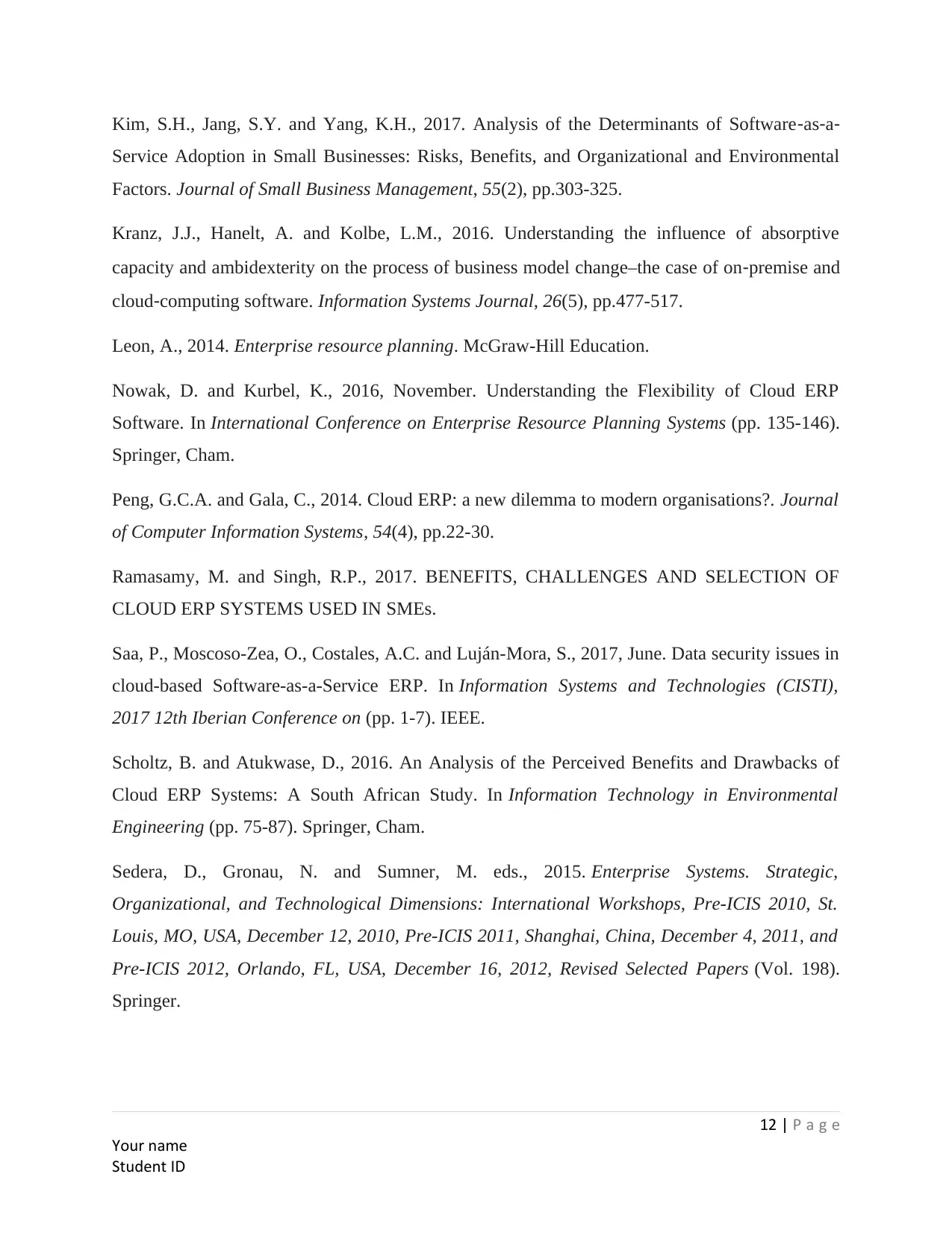
Kim, S.H., Jang, S.Y. and Yang, K.H., 2017. Analysis of the Determinants of Software‐as‐a‐
Service Adoption in Small Businesses: Risks, Benefits, and Organizational and Environmental
Factors. Journal of Small Business Management, 55(2), pp.303-325.
Kranz, J.J., Hanelt, A. and Kolbe, L.M., 2016. Understanding the influence of absorptive
capacity and ambidexterity on the process of business model change–the case of on‐premise and
cloud‐computing software. Information Systems Journal, 26(5), pp.477-517.
Leon, A., 2014. Enterprise resource planning. McGraw-Hill Education.
Nowak, D. and Kurbel, K., 2016, November. Understanding the Flexibility of Cloud ERP
Software. In International Conference on Enterprise Resource Planning Systems (pp. 135-146).
Springer, Cham.
Peng, G.C.A. and Gala, C., 2014. Cloud ERP: a new dilemma to modern organisations?. Journal
of Computer Information Systems, 54(4), pp.22-30.
Ramasamy, M. and Singh, R.P., 2017. BENEFITS, CHALLENGES AND SELECTION OF
CLOUD ERP SYSTEMS USED IN SMEs.
Saa, P., Moscoso-Zea, O., Costales, A.C. and Luján-Mora, S., 2017, June. Data security issues in
cloud-based Software-as-a-Service ERP. In Information Systems and Technologies (CISTI),
2017 12th Iberian Conference on (pp. 1-7). IEEE.
Scholtz, B. and Atukwase, D., 2016. An Analysis of the Perceived Benefits and Drawbacks of
Cloud ERP Systems: A South African Study. In Information Technology in Environmental
Engineering (pp. 75-87). Springer, Cham.
Sedera, D., Gronau, N. and Sumner, M. eds., 2015. Enterprise Systems. Strategic,
Organizational, and Technological Dimensions: International Workshops, Pre-ICIS 2010, St.
Louis, MO, USA, December 12, 2010, Pre-ICIS 2011, Shanghai, China, December 4, 2011, and
Pre-ICIS 2012, Orlando, FL, USA, December 16, 2012, Revised Selected Papers (Vol. 198).
Springer.
12 | P a g e
Your name
Student ID
Service Adoption in Small Businesses: Risks, Benefits, and Organizational and Environmental
Factors. Journal of Small Business Management, 55(2), pp.303-325.
Kranz, J.J., Hanelt, A. and Kolbe, L.M., 2016. Understanding the influence of absorptive
capacity and ambidexterity on the process of business model change–the case of on‐premise and
cloud‐computing software. Information Systems Journal, 26(5), pp.477-517.
Leon, A., 2014. Enterprise resource planning. McGraw-Hill Education.
Nowak, D. and Kurbel, K., 2016, November. Understanding the Flexibility of Cloud ERP
Software. In International Conference on Enterprise Resource Planning Systems (pp. 135-146).
Springer, Cham.
Peng, G.C.A. and Gala, C., 2014. Cloud ERP: a new dilemma to modern organisations?. Journal
of Computer Information Systems, 54(4), pp.22-30.
Ramasamy, M. and Singh, R.P., 2017. BENEFITS, CHALLENGES AND SELECTION OF
CLOUD ERP SYSTEMS USED IN SMEs.
Saa, P., Moscoso-Zea, O., Costales, A.C. and Luján-Mora, S., 2017, June. Data security issues in
cloud-based Software-as-a-Service ERP. In Information Systems and Technologies (CISTI),
2017 12th Iberian Conference on (pp. 1-7). IEEE.
Scholtz, B. and Atukwase, D., 2016. An Analysis of the Perceived Benefits and Drawbacks of
Cloud ERP Systems: A South African Study. In Information Technology in Environmental
Engineering (pp. 75-87). Springer, Cham.
Sedera, D., Gronau, N. and Sumner, M. eds., 2015. Enterprise Systems. Strategic,
Organizational, and Technological Dimensions: International Workshops, Pre-ICIS 2010, St.
Louis, MO, USA, December 12, 2010, Pre-ICIS 2011, Shanghai, China, December 4, 2011, and
Pre-ICIS 2012, Orlando, FL, USA, December 16, 2012, Revised Selected Papers (Vol. 198).
Springer.
12 | P a g e
Your name
Student ID
Paraphrase This Document
Need a fresh take? Get an instant paraphrase of this document with our AI Paraphraser
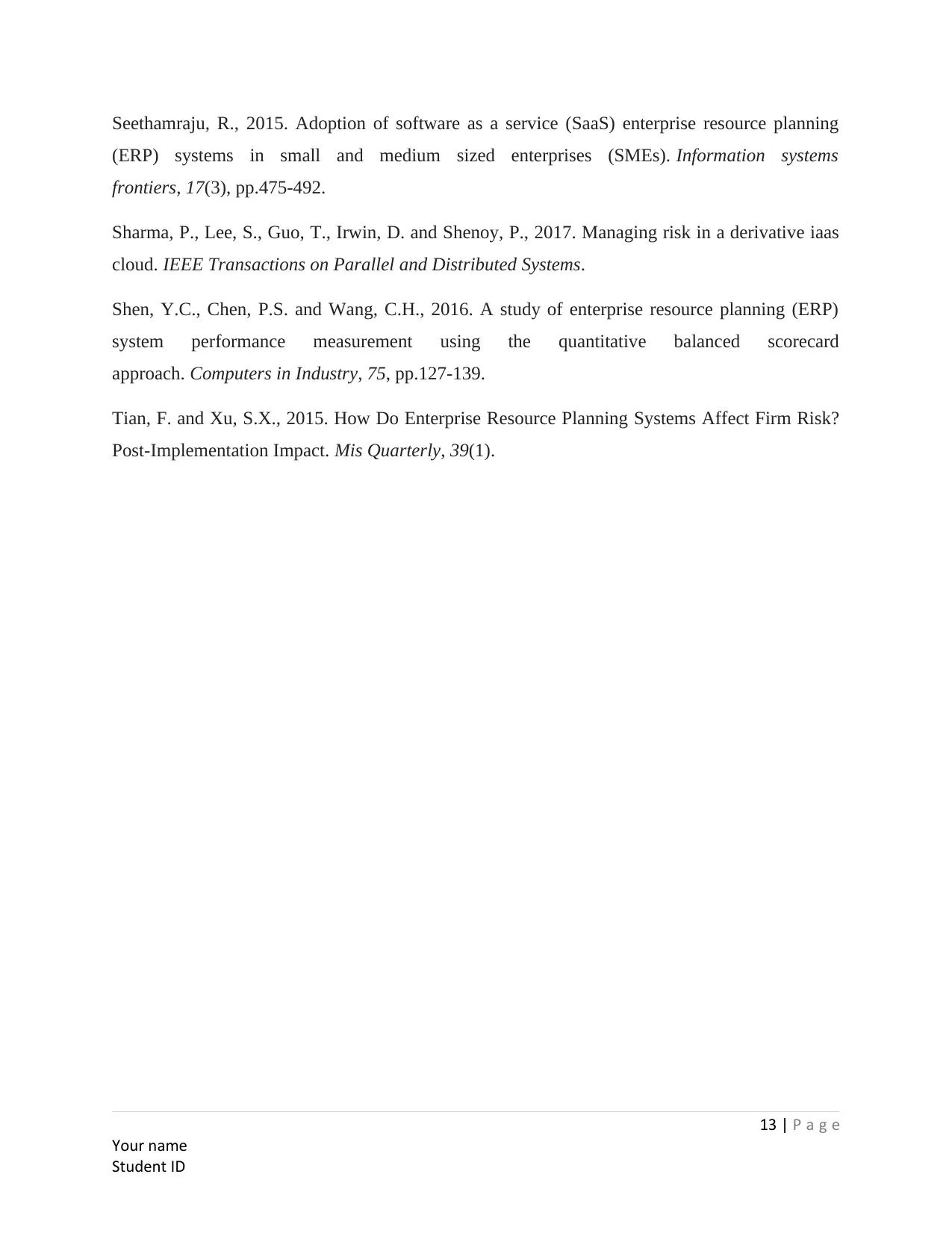
Seethamraju, R., 2015. Adoption of software as a service (SaaS) enterprise resource planning
(ERP) systems in small and medium sized enterprises (SMEs). Information systems
frontiers, 17(3), pp.475-492.
Sharma, P., Lee, S., Guo, T., Irwin, D. and Shenoy, P., 2017. Managing risk in a derivative iaas
cloud. IEEE Transactions on Parallel and Distributed Systems.
Shen, Y.C., Chen, P.S. and Wang, C.H., 2016. A study of enterprise resource planning (ERP)
system performance measurement using the quantitative balanced scorecard
approach. Computers in Industry, 75, pp.127-139.
Tian, F. and Xu, S.X., 2015. How Do Enterprise Resource Planning Systems Affect Firm Risk?
Post-Implementation Impact. Mis Quarterly, 39(1).
13 | P a g e
Your name
Student ID
(ERP) systems in small and medium sized enterprises (SMEs). Information systems
frontiers, 17(3), pp.475-492.
Sharma, P., Lee, S., Guo, T., Irwin, D. and Shenoy, P., 2017. Managing risk in a derivative iaas
cloud. IEEE Transactions on Parallel and Distributed Systems.
Shen, Y.C., Chen, P.S. and Wang, C.H., 2016. A study of enterprise resource planning (ERP)
system performance measurement using the quantitative balanced scorecard
approach. Computers in Industry, 75, pp.127-139.
Tian, F. and Xu, S.X., 2015. How Do Enterprise Resource Planning Systems Affect Firm Risk?
Post-Implementation Impact. Mis Quarterly, 39(1).
13 | P a g e
Your name
Student ID
1 out of 14
Related Documents
Your All-in-One AI-Powered Toolkit for Academic Success.
+13062052269
info@desklib.com
Available 24*7 on WhatsApp / Email
![[object Object]](/_next/static/media/star-bottom.7253800d.svg)
Unlock your academic potential
© 2024 | Zucol Services PVT LTD | All rights reserved.




